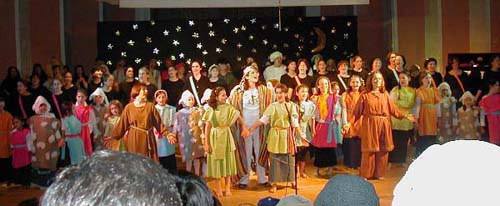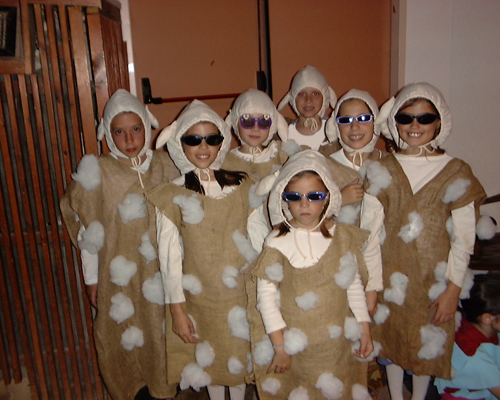
By Toby Klein Greenwald

JERUSALEM–These latest parshiot (chapters) of the Torah readings remind me of the summer and fall of 2001, when the women of the Raise Your Spirits Theatre put on the production Joseph and the Amazing Technicolor Dreamcoat to sold-out audiences who came on bulletproof buses from all over Israel to our community center in Gush Etzion. The goal was to raise our own spirits and the spirits of others in the midst of a bloody intifada.
On opening night, 20 minutes to show time, I found myself, as director, confronted by a problem of Solomonic proportions. Two little girls came to me in tears. Due to a miscount, we were one sheep costume short, and each of them claimed the last costume. True, 30-some girls in the production were costumed in colored tunics as Jacob’s grandchildren, and there were more of those costumes available. But the ten “sheep” — an arbitrary number – dressed in burlap cloaks with cotton wool pasted on, had the most coveted role. Go figure.
My solution: There were two acts in the play, so I suggested that the girls alternate at being a sheep. By next performance, I promised, we’d add another piece of burlap.

And the decision was good in their eyes.
Joseph’s brothers had, understandably, a more difficult time with their sibling’s colorful coat than did our two sheep with their rivalry over a costume. And no wonder: The coat that Jacob gave his favorite son (Genesis 37:3) was not just a doting father’s extravagance. This was not just a conflict over a garment, but over a role – not for a night, but for a lifetime.
The angry brothers knew exactly what Joseph’s coat represented, and it was not fashion or money or even fatherly love, painful as it was for them to discover that he was more favored than were they. Joseph’s coat stood for something they coveted more than all those things. The Renaissance-era Italian commentator Sforno stages it the most explicity: Joseph’s coat “was a sign that he would be a leader both in the home and in the field.”
Today, elementary business communication seminars teach that more is remembered of a presenter’s appearance than of the content. But even in those days, ordinary shepherds understood the symbolism in Jacob’s gift. The renowned 20th-century educator, Howard Gardner, author of Frames of Mind, makes the point that there are seven or more forms of intelligence through which people think and learn — one of which is the visual. Joseph’s brothers certainly could think visually. No word or action of Jacob’s could have sent the message more clearly to his other sons than did a stunning piece of clothing: This son of his beloved Rachel would some day be their leader.
The most accepted understanding of the description of Joseph’s coat is that the pasim, the stripes, were strips of colored wool. Why not a coat of pure white, the quintessential symbol of purity? Because clothing is a metaphor for behavior, and white is for angels, not people. A coat of many colors, on the other hand, is a metaphor for what made Joseph a leader.
Behavior, like clothing, is external. It is the part of our personality that is visible. Philosophers who beat their wives, men of religion who abuse children, erudite pretenders to greatness – all garner our disdain. The leader’s cloak of actions – not his thoughts or beliefs – is what ultimately inspires others to follow him.
What, then, is the “color” of Joseph’s leadership? It is rich, complex and multifaceted. Joseph became an economic leader in Egypt and, later, a caring and wise political leader of his brethern and their progeny. Joseph goes through a plethora of experience and behaviors – from narcissm to fear to courage to faith to strength to repentance to forgiveness. These events and feelings not only prepare Joseph to be a leader, but are fed into the collective unconscious of the Jewish people through him.
There are two similar images in the Torah, showing that the multiple colors in Joseph’s coat are not incidental. One is the image of the rainbow that came out after the flood, God’s way of assuring Noah that the world would never again be destroyed by water – a symbol of human survival. The other is the breastplate of the high priest who served in the Temple as the spiritual leader of the Jewish people. The breastplate had 12 magnificently colored inlaid precious stones. It was worn by the individual who was deemed closest to God, who was the symbol of spiritual fulfillment. Just as the rainbow’s message to the world foreshadowed the story of Joseph, so did the breastplate continue his message.
The common secret of the rainbow, Joseph’s coat and the breastplate of the priest, is that for a person to grow, develop and survive as an individual, a member of a nation and a citizen of the world, he was to look to the colors and complexity within himself and within his sisters and brothers. For a nation to survive, it must regard this richness of variety not as a curse, but as a blessing.
We could certainly use a leader like Joseph today, whose swirling colored coat, like his open and loving heart in his adult years, symbolized and encompassed all of the intricacy and seeking of the children of Israel.
The author is a writer, educator, award-winning theater director and the editor of WholeFamily.com. She is currently directing the eighth production of Raise Your Spirits, called “Count the Stars,” on the story of Abraham and Sara.